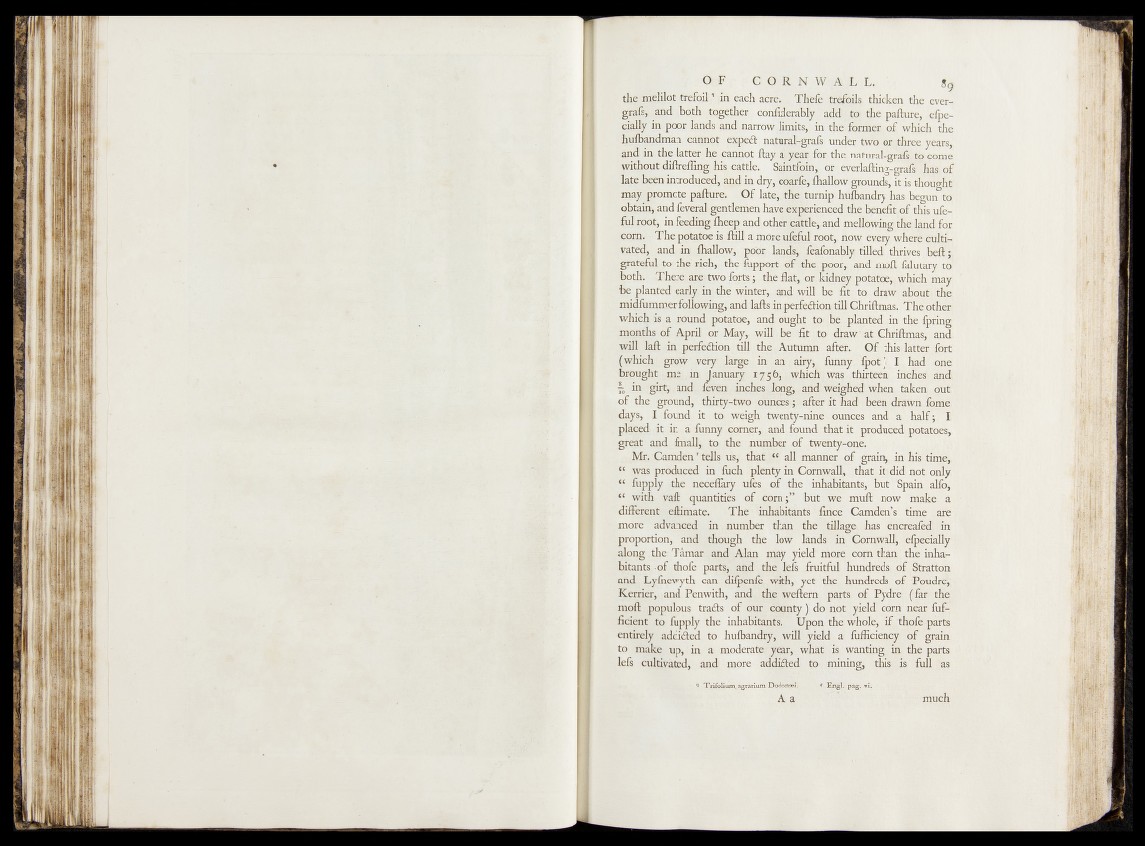
o F C O R N W A L L. ' 8g
the melilot |in - eaeh.'acrS Thefe trefoils thicken, the ever-
■ ^othi^^fogellier conjMefmhtyjl add ! tof the paflure, efpe-.
c ^ r in poor lajijls which the
''^yfoandman caiinot erned natM fefejjafs uncler tWoqr, three years,
and in th-W^-^i^^TOot ftay, Jljear^for the natural-grafoto come
‘ ^ithqWdifocihhg his.,cattle. Sain^tphi, or,: everlafong-grall has of
^lateheen introduced, apd |o dry; coiffe,' ihallow grounds, it is thought
ma-|||tomote paRpre. Of lat|-j.mfe turiiip hu|bandry, ha^ begun^
obtain* and ferorghgchilcmen have experienced the benefit of this,ufe-!
fulujpqt, in feeding^^hapd otheWc^ttle, and mellowing jthe land for,
Iqo^ar; The potatoe is foil a more ufeful navi| everywhere culti-
, vated, and in (hallow, poor lands, feafona|lj| tilled, thrives, Ijeft” j
grateful to the rich, th^> fiipport of'.the, poor, ^ WdWoffi .failu,tary to
Roth.' The^e ate^ two forts; the flat, or
be plantedgady, in; the winter ;.y and'jwill fc^ fit draw apdnb.'thej.
n\idfununer following, andlafts iqpeWdi(^ti!i<^i:iftmas. The other*
which is a, round pqtjtoe, anc( oughtlS|o||Be planted ^in the fpring
months of April or May, will be fit, ‘ to- at Chriftmas, and
■ pyill laft in perfedion till > the' Autumn after. Of
(which grow very' large in a n , airy, .foxiny/fpoh) h„ had ,one,
brought ;me^in January 1756, which was thirteen inchesV and
To in5|girt, and feven inches long, and weighed yfh^n taken outƒ
of the ground, tfiirty-two ounces;;-'after it had been drawn feme»
days, I [foupd- it to weigh twenty-nine, ounces a p d l^ h ^ f ; I,
placed it in a funny corner,, ^ and found that it produced potatoes,
great and final], to the number .of, twenty-one.
Mrt.Cam.deh| tells us,1 that all manner of grain, in his* time,}
t{ was produced in ftich plenty in Cornwall, that itidid not* only
.fupply the neceflary ufes of the inhabitants, },bht ^Spairi alfo; ’
“ with vaft quantities of corn;” but we muft now make a
different effimate. The inhabitants fince Camden’s time are
more advanced in , number than the tillage has encreafod in
proportion, and though the low lands in Cornwall, -;'efp8cially
along the TamafSand Alan may yield more corn than itthe inhabitants
of thofe parts, and the lefs fruitful hundreds of Stratton
and Lyfnewyth can difpenfe with, yet the hundreds of Tpudro,’'-
Kerrier, and Penwith, and the, Weflern parts of Pydres, | far;''the
moft populous trads of our. ctipnty) do not, yield corn near fuf-*
ficient to fupply the inhabitants. Upon the whole, . if, thofe parts
entirely addided to hufbandry, will yield a fufficiency of grain
to make up, in a moderate'year, what is "wanting^,in the parts
lefs cultivated, and more addided to mining, this,,'is’ full "'as
Trifoli unvagraritim Dodonsei.
A a '
r- Engl. pag. vi.
much